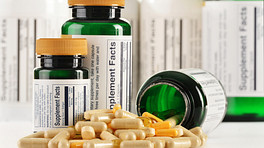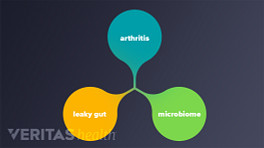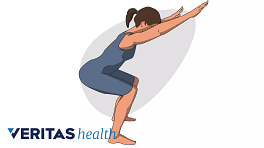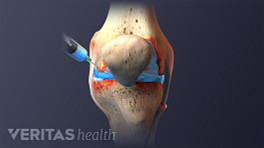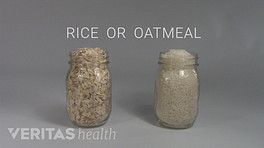When you have arthritis, making certain changes to your diet and lifestyle can make a big difference to your joint pain. Try one or more of these strategies to help you relieve achy joints and stay active.
1. Try an anti-inflammatory, plant-based diet
What you eat may have a direct connection with inflammatory flares or pain relief in your joints. Research suggests following an anti-inflammatory, plant-based diet that emphasizes unprocessed, whole foods may help relieve arthritis joint inflammation, thereby reducing stiffness and pain. 1 Sarris, J. & Wardle, J. Musculoskeletal system. In: Sarris, J. & Wardle, J. Clinical naturopathy : In Practice. Chatswood, NSW: Elsevier; 2017.
See An Anti-Inflammatory Diet for Arthritis
This type of diet may also help you control your weight and reduce stress on weight-bearing joints such as knees and ankles. A few examples of foods included in this diet are:
- Nuts
- Fruits
- Leafy greens
- Tofu
- Whole grains
- Green tea
These foods are rich in antioxidants. Antioxidants prevent certain chemical reactions in the body that can lead to cell and tissue damages.
See What Are Anti-Inflammatory Foods?
Avoiding refined and/or processed foods is also essential, as these foods may cause or increase inflammation.
2. Take a supplement
In addition to eating anti-inflammatory foods, taking a dietary supplement may help reduce arthritis pain. A few examples are:
- Curcumin. Curcumin has been widely researched for its anti-inflammatory properties. Curcumin is found to be as effective as pain-relieving medications such as ibuprofen in reducing arthritic joint pain. 2 Kuptniratsaikul V, Dajpratham P, Taechaarpornkul W, et al. Efficacy and safety of Curcuma domestica extracts compared with ibuprofen in patients with knee osteoarthritis: a multicenter study. Clin Interv Aging. 2014;9:451-8. Published 2014 Mar 20. doi:10.2147/CIA.S58535
- Omega 3 fats. Evidence shows that consuming omega-3 fatty acids can lead to a modest reduction in the symptoms of arthritis.
3
Calder PC. Omega-3 fatty acids and inflammatory processes: from molecules to man. Biochem Soc Trans. 2017;45(5):1105-1115.
See The Difference Between Omega-3 and Omega-6 and Knee Arthritis Pain
- Vitamin D. Vitamin D may help build strong bones and reduce arthritic joint pain especially in rheumatoid arthritis (RA). Research suggests people with RA may be at a higher risk of vitamin D deficiency and may benefit from supplementation. 4 Kostoglou-Athanassiou I, Athanassiou P, Lyraki A, Raftakis I, Antoniadis C. Vitamin D and rheumatoid arthritis. Ther Adv Endocrinol Metab. 2012;3(6):181-7.
It is important to discuss a new supplement with your doctor to make sure it does not adversely interfere with your health or current medications.
See Dietary Supplements for Treating Arthritis
3. Engage in physical activities
Research suggests exercising may help reduce joint pain and improve arthritis in some people. 5 Metsios GS, Stavropoulos-Kalinoglou A, Kitas GD. The role of exercise in the management of rheumatoid arthritis. Expert Review of Clinical Immunology. 2015;11(10):1121-1130. doi:10.1586/1744666x.2015.1067606. Exercising helps release feel-good hormones (endorphins) and can also help you feel relaxed and improve concentration. Exercises such as leg flutter kicks, arm/leg raises, and/or shoulder stretches are easy and can be performed at home.
If you do not like to exercise, performing daily activities that are joint-friendly are also a good way to stay active throughout the day. A few examples include:
- Taking the stairs
- Using a basket for light grocery shopping
- Tending your garden
- Riding your bike
- Parking in a distant spot to get a good walking distance
Research suggests engaging in exercise and physical activity may also help alleviate depression. 5 Metsios GS, Stavropoulos-Kalinoglou A, Kitas GD. The role of exercise in the management of rheumatoid arthritis. Expert Review of Clinical Immunology. 2015;11(10):1121-1130. doi:10.1586/1744666x.2015.1067606. , 6 Kelley GA, Kelley KS. Exercise reduces depressive symptoms in adults with arthritis: Evidential value. World J Rheumatol. 2016;6(2):23-29.
See Knee Exercises for Arthritis
It is important to note that exercises must always be performed within tolerable limits.
See Shoulder Exercises for Arthritis
4. Try heat and/or ice therapy
Heating and/or icing an achy joint is an easy and inexpensive way to relieve joint pain. While this treatment may not improve the joint condition, it may ease the pain and make you feel more comfortable.
- Heat can help relieve muscle and joint stiffness, warm up joints before activity, and/or ease a muscle spasm.
- Cold can help reduce joint inflammation, swelling, and pain.
See Applying Heat vs. Cold to an Arthritic Joint
You can also heat and ice alternately. For example, you can use heat therapy in the morning to loosen up a stiff joint and use cold therapy to reduce swelling a few hours later.
See When and Why to Apply Cold to an Arthritic Joint
Ice and/or heat therapy must be limited to 15 or 20 minutes at a time with at least a 2-hour break in between applications to reduce the risk for a skin injury.
See When and Why to Apply Heat to an Arthritic Joint
5. Talk to your doctor about hyaluronic acid injections
Hyaluronic acid joint injections may help improve the functions of arthritic joints. These injections may:
- Reduce joint pain
- Improve joint movement by increasing joint lubrication and reducing joint friction and inflammation
- Slow the progression of osteoarthritis in some people
See Hyaluronic Acid Injections for Knee Osteoarthritis
Although these injections are approved by the FDA only for treating knee osteoarthritis, they are sometimes used off-label to treat the hip and other joints. Some doctors also use hyaluronic acid injections to treat the symptoms of rheumatoid arthritis.
It is important to remember that these strategies should not be pursued as a replacement for medications and standard care. If your arthritis symptoms don’t improve, seek help from a qualified health professional.
Learn more:
- 1 Sarris, J. & Wardle, J. Musculoskeletal system. In: Sarris, J. & Wardle, J. Clinical naturopathy : In Practice. Chatswood, NSW: Elsevier; 2017.
- 2 Kuptniratsaikul V, Dajpratham P, Taechaarpornkul W, et al. Efficacy and safety of Curcuma domestica extracts compared with ibuprofen in patients with knee osteoarthritis: a multicenter study. Clin Interv Aging. 2014;9:451-8. Published 2014 Mar 20. doi:10.2147/CIA.S58535
- 3 Calder PC. Omega-3 fatty acids and inflammatory processes: from molecules to man. Biochem Soc Trans. 2017;45(5):1105-1115.
- 4 Kostoglou-Athanassiou I, Athanassiou P, Lyraki A, Raftakis I, Antoniadis C. Vitamin D and rheumatoid arthritis. Ther Adv Endocrinol Metab. 2012;3(6):181-7.
- 5 Metsios GS, Stavropoulos-Kalinoglou A, Kitas GD. The role of exercise in the management of rheumatoid arthritis. Expert Review of Clinical Immunology. 2015;11(10):1121-1130. doi:10.1586/1744666x.2015.1067606.
- 6 Kelley GA, Kelley KS. Exercise reduces depressive symptoms in adults with arthritis: Evidential value. World J Rheumatol. 2016;6(2):23-29.


